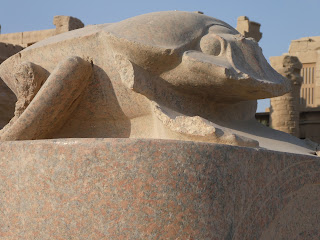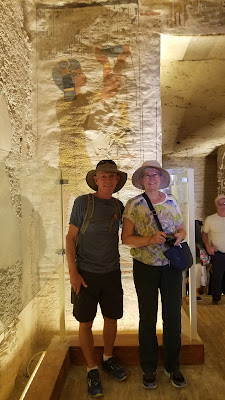We leave the current capital, Cairo, and fly to its ancient capital of Thebes, which is now known as Luxor.
 |
| Internet photo |
It is a city of temples built over 2000 years, and although today it is a mix of decayed temples, chapels, pylons, and statues in the process of being restored...
...in its day it must have been awe-inspiring.
Here's an internet drawing of the entire complex as it may have looked. It covers about 200 acres.
Karnak is one of the most important ancient sites in all of Egypt. Ancient Egyptians, who believed that their chief god, Amun-Ra, first created himself and then everything else, called Karnak "the most perfect of places".
Here's the entrance into the temple.
With the avenue of ram-headed sphinxes...
In the photo below the sphinx is the symbol of the god Amun--it protects the pharaoh who stands between the front paws.
It is here that we are seeing our first hieroglyphs--pictures of an object representing a word, syllable or sound in ancient Egypt. Hieroglyphs are all over the columns in the temple. There were 134 columns.
Our Trip Leader, Tarek, could actually read this, but I've forgotten what it says.
We wandered around obelisks...
and statues...
and even a large scarab...a dung beetle regarded as sacred in ancient Egypt.
Karnak was called the most perfect of places. And perfection was eventually attained over the course of 2,000 years by successive kings and queens, who each added their own tributes to Amun-Ra, replacing or expanding existing monuments in ever more grand styles.
Here's a drawing from the internet of what it may have looked like in all its splendor.
That afternoon we checked into our hotel, the Sofitel Winter Palace built in 1886. Once a winter retreat for the Egyptian royal family, it is here Agatha Christie wrote her famed 1937 novel, Death on the Nile.
Located on the banks of the Nile, it was very nice!
Oh, yeah!
In the evening we explored Luxor Temple with many of the same kind of columns and statues, but with a different look as it was all lit up in the dark of the night.
Luxor Temple was a center of power for Egypt's mighty pharaohs over a nearly 1500-year period. The temple complex was largely built by pharaohs Amenhotep III and Ramses II. Ramses II was the greatest most celebrated pharaoh of the New Kingdom.
The statues are HUGE!!
Luxor Temple was “the place of the First Occasion,” where the god Amun experienced rebirth during the pharaoh’s annually reenacted coronation ceremony. There is a processional way called the Avenue of Sphinxes, which linked the Temple of Karnak with the Temple of Luxor about one and a half miles away.
The next morning it was time to explore the Valley of the Kings. This is where the great pharaohs were buried in rock-cut tombs and surrounded by all the treasures they would need in the afterlife.
No pyramids here, although the mountain of rock where the tombs are located certainly resembles one.
We head into the valley...
...and we can see the entrances to several tombs. Without a modern man-made entrance you can imagine how hidden these tombs would be when sealed. They must have learned how easy it was for the pyramids to be looted. Here they wanted the tomb to be completely hidden.
Here's a closer look at one...
We went inside several tombs....
All of the walls and ceilings were covered in Egyptian hieroglyphs and art depicting the life and accomplishments of the pharaoh entombed here and scenes of what the pharoah hoped his afterlife would be like.
Of course all the treasures are gone...carried off long ago when the tombs were violated.
Currently, there are 62 tombs that have been discovered in the Valley of the Kings. There is speculation that there are many more. Here is the map to date.
The tomb marked KV62 is probably the most famous of all as it is King Tutankhamen's tomb,
Most of the ancient Egyptian tombs had already been discovered, but Carter knew that King Tut's tomb was still unaccounted for. He began an intensive search and finally found steps to the burial room hidden safely away in the debris near the entrance of a nearby tomb.
And his tomb had been untouched. Carter later wrote about what he saw as he peered in a small hole he made in a sealed doorway. "As my eyes grew accustomed to the light, details of the room within emerged slowly from the mist, strange animals, statues, and gold--everywhere the glint of gold". When Lord Carnarvon asked if he could see anything, Carter replied, "Yes, wonderful things."
A photo from the internet, this is what Carter saw.
A lot of the treasures found are now on display in museums around the world. A little trivia for those of you interested in the show Downton Abbey. That show was filmed in Highclere Castle, once the home of Lord Carnarvon. If you visit the castle, you can also see an exhibit of items from King Tut's tomb.
No photos were allowed inside King Tut's tomb, but the internet has some, so here is what we saw of the burial chamber. There is new evidence today suggesting the existence of more rooms hidden beyond the burial chamber.
We also visited the Temple of Queen Hatshepsut, built for Egypt's first known female monarch. Ruling for 20 years in the 15th century BC, Hatshepsut is considered one of Egypt's most successful pharaohs.
That evening our tour group split into groups of 4-5 and enjoyed a home-hosted dinner with a local family. This is the family we visited. We learned about their daily life in Egypt...
...and had a delicious meal.
The next day we begin cruising the Nile, but before we board the ship, we will sail over Luxor in an early morning hot air balloon.
To continue reading, scroll down and click on "Newer Post".


































No comments:
Post a Comment